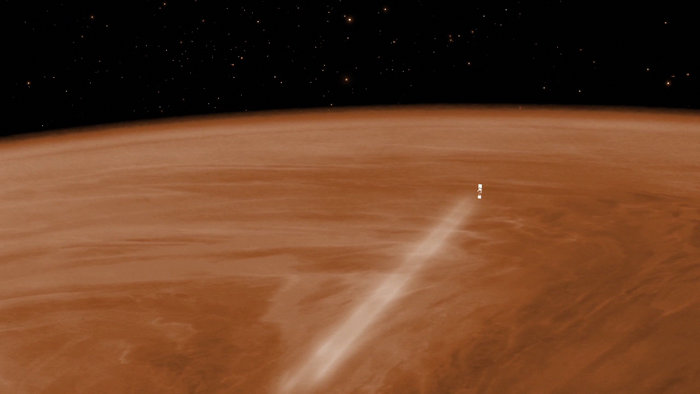Before, normal operations involved an elliptical orbit every 24 hours that took Venus Express from 66,000 km over the south pole down to around 250 km at the north pole, just above the top of the atmosphere. The recent aerobraking campaign took the craft progressively lower into the atmosphere on its closest approaches and directly explored previously uncharted regions of the atmosphere.
Aerobraking can be used to reduce the speed of a spacecraft approaching a planet or moon with an atmosphere, allowing it to be captured into orbit, and to move from an elliptical orbit to a more circular one. Less fuel has to be carried, yielding benefits all round. The technique will be used on future missions and the Venus Express experiments will help guide their design.

Visualization of Venus Express during the aerobraking maneuver. Credit: ESA–C. Carreau
“We have collected valuable data on the Venusian atmosphere in a region difficult to characterise by other means,” says Håkan Svedhem, ESA’s Venus Express project scientist.“The results show that the atmosphere seems to be more variable than previously thought for this altitude range, but further analysis will be needed in order to explain these variations properly.”
Between altitudes of 165 km and 130 km, the atmospheric density increases by a factor of roughly a thousand, meaning that the forces and stress encountered by Venus Express were much higher than during normal operations.
It also experienced extreme heating cycles, with temperatures rising by over 100ºC during several 100 second-long passages through the atmosphere.
In addition, the atmospheric drag at these lower altitudes was so great that the spacecraft’s orbital period was reduced by more than an hour.
“The spacecraft has proven to be very robust and has apparently experienced no substantial degradation in any area, but a detailed evaluation is still to take place,” says Joerg Fischer, Venus Express operations engineer.
Credit: SA/MPS/DLR/IDA, M. Pérez-Ayúcar and C. Wilson
At the end of the campaign, 15 thruster burns raised the craft’s altitude, preventing it from dropping into the atmosphere. The last was executed on Thursday evening, boosting Venus Express to a new altitude of 460 km at its closest and 63 000 km at its furthest. This new orbit takes 22 hours 24 minutes to complete.
“During the 15 manoeuvres, each thruster fired more than 8,000 pulses and burned a total of about 5.2 kg of propellant to raise the spacecraft to this new altitude,” said Joerg.
Source: ESA






Comments